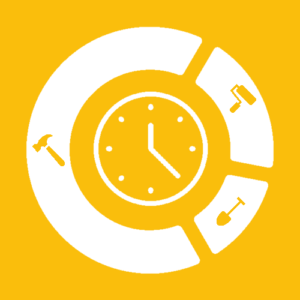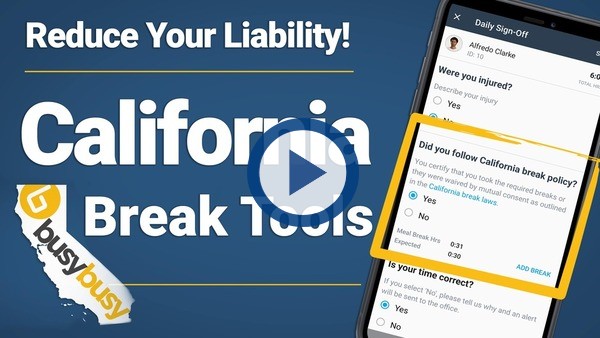What are California’s break rules?
California state law now mandates that employees receive one (1) ten-minute rest break every four hours they work. Employees who work a normal eight-hour shift would be entitled to two (2) ten-minute rest breaks during the day. These breaks must be paid by the employer and land preferably somewhere in the middle of the four-hour stretch. The ten minutes can be used for anything the employee wishes, including grabbing a bite to eat, running an errand, or using the restroom.
In addition, employees must receive an uninterrupted and duty-free 30-minute meal break for every five hours worked in a day. Unlike the rest breaks, these meal breaks are unpaid. The employee can leave the worksite to eat but must be relieved of all work duties during that time.
The penalty for violating either of these rules is one hour’s wage for every day an employee doesn’t receive a rest break and an additional hour’s wage for every day an employee doesn’t receive a meal break.
A number of exemptions exist, so be sure to check the state’s Department of Industrial Relations website and with your legal counsel to make sure everything is up to date.
How do I calculate California breaks?
California employees receive one (1) paid ten-minute rest break for every four hours they work each day. If the employee works more than six hours, they qualify for two (2) rest breaks in an eight-hour shift.
| Hours on the Clock | Rest Breaks |
| 0 – 3:29 hrs | 0 |
| 3:30 – 6 hrs | 1 |
| 6:01 – 10 hrs | 2 |
| 10:01 – 14 hrs | 3 |
| 14:01 – 18 hrs | 4 |
| 18:01 – 22 hrs | 5 |
For example, employees who work seven-hour shifts qualify for two (2) ten-minute rest breaks per day.


Employees must also receive an uninterrupted 30-minute meal break for every five hours worked in a day. Unlike rest breaks, these meal breaks are unpaid.
| Hours on the Clock | Meal Breaks |
| 0 – 5 hrs | 0 |
| 5:01 – 10 hrs | 1 |
| 10:01 – 15 hrs | 2 |
| 15:01 – 20 hrs | 3 |
| 20:01 – 24 hrs | 4 |
For example, if an employee works a 17-hour shift, they qualify for three (3) unpaid 30-minute meal breaks. While the employee is on the job for the full 17-hour shift, 1.5 hours will be unpaid from the meal breaks, resulting in 15.5 total hours worked that day.
If those employees are not completely relieved of all duties for their meal break (like a security guard at the job site), their on-duty meal period must be at least 30 minutes.
Who is eligible for California breaks?
Employees over the age of 16 with authorization to leave school for work
Employees over the age of 18
Employees not working in executive, professional, or administrative roles
Who is exempt from California break rules?
Administrative employees: A person whose job includes office or non-manual labor using specialized skills or training with minimal or general supervision. This person must earn more than twice the state’s minimum wage.
Professional employees: A person whose work is in areas like law, architecture, engineering, accounting, or art. Like administrative employees, they must earn more than twice the state’s minimum wage.
Executives: A person who runs or manages the company (or a subdivison/department) and supervises more than two employees. They have the authority to hire, promote, demote, and fire employees and, like professional and administrative employees, must earn twice the state’s minimum wage.
To get all the information you might need about exemptions, visit California’s Department of Industrial Relations website and get professional advice.
Can an employee Skip or Waive their Breaks?
Employers are required by law to make timely meal and rest breaks available to employees, but the employer is not required to make the employee take them. That is up to the employee. If the employee decides to skip or waive their meal or rest break voluntarily or to take them late, with no pressure or encouragement from the employer, that is legally permitted.
However, employers have the right under California labor laws to set the employee’s work schedule, including their break schedule. While not required, employers have the right to order employees to go on their meal and rest breaks. If the employee doesn’t comply, the employer has the right to discipline or terminate the employee for insubordination. So it is always a good idea for the employer and employee to discuss all intentions to skip or waive any meal or rest breaks or to take them late.
Other California Meal Break Law Requirements
If an employee works over 5 hours a day, they are entitled to a meal break of at least 30-minutes that must start before the end of the fifth hour of your shift. BUT, they can agree with their employer to waive this meal period provided the employee does not work more than 6 hours in the workday. They can also decide on an on-duty meal break which counts as time worked and is paid.
If an employee works over 10 hours a day, they are entitled to a second meal break of at least 30-minutes that must start before the end of the tenth hour of their shift. The employee can agree with their employer to waive the second meal break if they do not work more than 12 hours and did not waive their first meal break.
The employee must be allowed to take their meal break off the work premises and spend their break however they wish since it is off the clock.
Employees cannot be required to work during any required meal break. [Cal. Lab. C. 512].
As of 2012, the employer has an affirmative obligation to ensure that breaks are made available to the employee, but the actual taking of meal breaks is left to the employee. In other words, the employee is responsible for “breaking” themself.
Rest breaks and meal breaks are supposed to be separate; they should not be combined. Your boss cannot give you a single 1-hour break and say that counts as all your meal breaks and rest breaks.
SEE WHAT OUR CONSTRUCTION CUSTOMERS HAVE TO SAY ABOUT
THE BUSYBUSY TIME CLOCK AND EQUIPMENT TRACKING APPS
![]()
MARK, VIP Painting
“Since I’ve started using BusyBusy, I’ve been able to have real, up to the minute visibility of so much vital information related to labor budgets {and break times} that I am actually able to make necessary timely adjustments to help me be profitable. Love this app!”
![]()
BRAD, Sun Painters, Inc.
“My employees love busybusy. They didn’t keep great {break} records before, and we felt like they were guessing half the time on payday. Now, I’m happy and they’re happy!”
![]()
ANWANUR, Allen Construction
“busybusy has helped us ensure the safety of our crews by knowing what site they are on at all times and allowed us to better see what people are spending their {break time} on so we can better anticipate needs for future projects.”
Cover Your Bases and
Avoid Costly Legal Headaches

busybusy can make tracking and recording your employee breaks as simple as opening our app, even if breaks have been waived by mutual consent.

How do I track California breaks for my employees?
Keeping track of all the new regulations on paper could be a nightmare. busybusy has you covered with built-in features specifically designed to help California contractors stay on top of the 2020 California meal and rest breaks and overtime law.

Eliminate paper timecards and streamline your payroll
Reclaim those wasted hours gathering up paper or emailed timecards and entering them in to the system with the busybusy Mobile Time Tracking app. Verified data can be exported straight from busybusy in to Quickbooks or a number of other payroll software suites.

Get real-time data to lower your job cost
Real-time data is the lifeblood of good decision making when it comes to staying on time and on budget. The busybusy Mobile Time Tracking app allows you to see which employees are on break and which project they’re currently working on, keeping you a step ahead to ensure work continues and breaks are all recorded accurately.

Remove the human error from payroll
With the push of a button on their mobile device, your employees can clock in and out, go to break, or move to a different job. Employees can receive location-based alerts to remind them to clock in or out as soon as they arrive or leave work. Supervisors can even batch any of these actions, completing tasks for the entire crew all at once.

Track employee time and location on the job
The busybusy Mobile Time Tracking App features fully-transparent GPS-based tracking so you know where your employees are working and when. No cell service or WiFi on the job? No problem! The app records the location and time stamps throughout the day, uploading them as soon as a connection can be found again.

Increase team connectivity & communication
Get everyone on the same page by setting employee expectations to ensure work on the site matches the planned budget. busybusy allows your crews to upload photos, notes, change orders, and other media to keep you and your supervisors up to date on what’s happening out on the job site.
